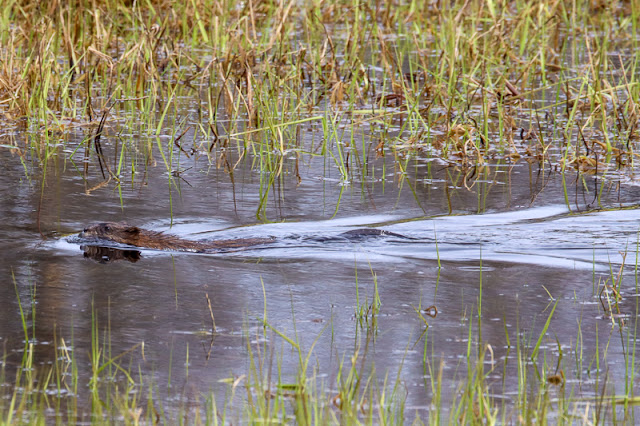Last week on my Facebook page (https://www.facebook.com/karen.casebeer.79) I wrote about the difficulties of distinguishing among the over 200 Finch varieties, and between the House Finch and Purple Finch, in particular.
Turns out Finches aren’t the only critters that are challenging to identify. In one area where I take pictures, there is a four corners with a different pond habitat on each corner. Each one has its own character. The one on the southwest corner is my favorite, probably because it backs up to where I most often see cranes. I call it Pond #1.
Interestingly, culverts beneath the four corners allow swimming critters to easily travel from one pond to another. On this particular day, I was sitting near the culvert at Pond #1, when a cute little critter popped up. It looked right at me, then quickly disappeared into the culvert, all too fast for me to photograph and identify. At first glance, it was tall and weasel-like, standing on its rear legs. A mink, was my first guess.
I was curious what the critter was so I returned over a few days. The next time I saw the critter, it was in Pond #3, on the northeast corner of the intersection. This particular pond changes a lot during the spring. Right after the snow melt, it’s a large round pond next to a farm. But as the season progresses, and the ground absorbs the moisture, the pond become a narrow stream from the culvert to the larger open pond. On this day, my critter swam in the stream back and forth to the large pond.
As I watched it swim, I noticed how fast it was, even creating a wake in its path, its tail working as quite the rudder. I began to think it might be a muskrat or a beaver versus a mink. I leaned toward muskrat because you can see a muskrat’s whole body as it swims, while with beavers, you usually see only their heads.
Sometimes the size and the tail are the key identifiers between these two semi-aquatic mammals. As this critter’s tail surfaced, I thought, beaver, definitely. But science blogger Matthew Miller cautions, “An often-overlooked aspect of wildlife viewing is the mental aspect. Be honest: you probably want to see a beaver more than you do a muskrat. So, the first thing you have to do is make sure your mind isn’t turning a muskrat into a beaver. Trust me, it happens.”
The next time I returned, the critter had just climbed from Pond #1 and was feeding on some dried vegetation on the verge. The wide, flat tail made me think beaver again, as the muskrat has a long, skinny tail with flat sides. Also, a beaver’s tail has no hair on it.
But the size didn’t seem right for a beaver. They are the largest rodent in North America, typically weighing between 35 and 68 pounds, with a length of between 39 and 47” long. Muskrats are much more lightweight, weighing between two and five pounds and measuring between 16 and 25 inches in length. As I sat in my car near this critter, it seemed much smaller than a normal beaver. Perhaps, it was a youngster.
By now, the critter and Gracie had discovered each other. While she didn’t bark, Gracie’s nose was twitching furiously as she headed to the car window to check out the new smells. The critter, which I’m tentatively calling a small beaver, hightailed it through the grass to the pond waters. As for me, I’m learning how challenging critter identification can be.








I'm guessing small beaver, Karen. Looking forward to more shots of this critter!
ReplyDeleteThanks, Jan. Me too.
ReplyDelete